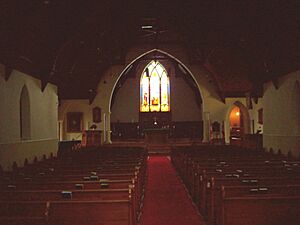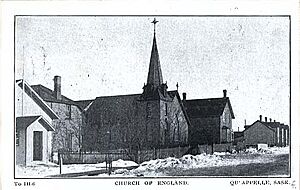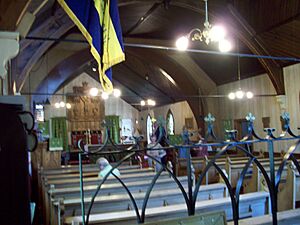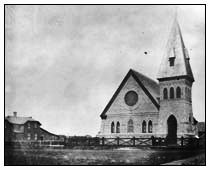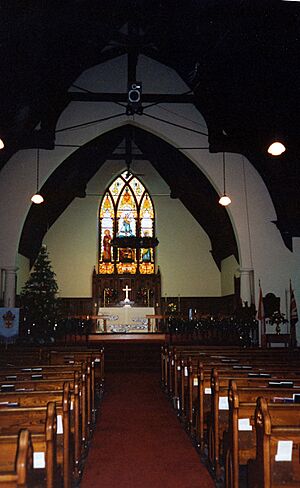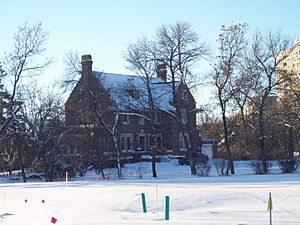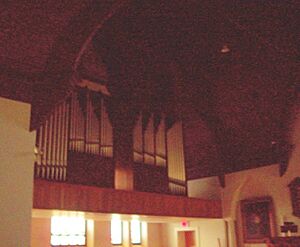St. Paul's Cathedral (Regina, Saskatchewan) facts for kids
Quick facts for kids St Paul's Cathedral |
|
|---|---|
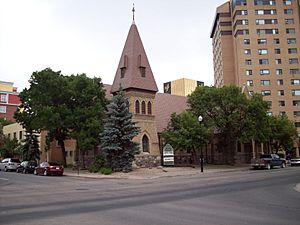
St Paul's Cathedral, Regina, 2008
|
|
| 50°26′57″N 104°36′58″W / 50.4491°N 104.6161°W | |
| Location | Regina, Saskatchewan |
| Country | Canada |
| Denomination | Anglican Church of Canada |
| Website | stpaulsregina.com |
| History | |
| Status | Cathedral |
| Founded | 1883 |
| Administration | |
| Parish | St Paul's |
| Deanery | Wascana |
| Diocese | Qu'Appelle |
| Province | Ruperts Land |
St Paul's Anglican Cathedral is a very old and important church in Regina, Saskatchewan, Canada. It was built a long time ago, between 1894 and 1895. At first, it was just a regular church for the local community. Later, in 1944, it became a "pro-cathedral" for the Anglican Diocese of Qu'Appelle. This meant it was a temporary main church for the area. Then, in 1973, it officially became the main cathedral for the diocese. This happened because plans for a much bigger cathedral in Regina didn't work out.
Contents
About St Paul's Cathedral
This church can seat about 300 people. It has a traditional design with a pointed roof. The church looks simple both inside and out. This shows that the Anglican Church in Western Canada was not very large or wealthy at the time it was built.
Inside the church, there is a special small chapel called the Lady Chapel. It is located to the south of the main altar area. There is also a columbarium in the basement. A columbarium is a place where people can keep the ashes of loved ones after cremation.
The church's history goes back to 1882, when the town of Regina was first started. The land for the church was bought then. In 1883, a wooden building was opened as the first church. The current brick and stone church was built in 1894–1895. Later, in 1905–06, more parts like the chancel (the area around the altar) and transepts (parts that stick out from the sides) were added. It is the oldest church building in Regina that is still being used today.
The church organ has been moved around a few times over the years. The pipes for the organ are now in the north transept, above where the choir sings.
St Paul's has an interesting history because:
- It started as a smaller church when the main church for the area was in a different town.
- It was meant to be a temporary main church before a much larger cathedral was built in Regina.
- But in the end, it became the official cathedral when the plans for the bigger church didn't happen.
History of the Cathedral
Long ago, the Anglican Church thought the village of Qu'Appelle, Saskatchewan would become a very important city. So, they chose it to be the main city for the new Diocese of Qu'Appelle. This was even though Regina was already starting to grow. St. Peter's Church in Qu'Appelle became the "pro-cathedral" (temporary main church) in 1885.
However, in 1883, Edgar Dewdney, a government leader, bought a lot of land in a place called Pile-of-Bones, which was soon renamed Regina. He decided Regina would be the capital city. This meant Qu'Appelle's importance started to fade.
Even so, people hoped Qu'Appelle would remain important. But by 1944, it was clear that Regina was the main city. So, St Paul's in Regina took over from St Peter's in Qu'Appelle as the pro-cathedral. The name "Qu'Appelle" is still used for the diocese because of the nearby Qu'Appelle Valley.
Once Regina became the capital of the province in 1905, it made more sense for the main church (cathedral) to be in the capital city. Over time, the main offices for the diocese, including the Bishop's Court and a theological college, moved from Qu'Appelle to Indian Head, Saskatchewan and then to Regina.
By 1944, St Paul's in Regina officially became the pro-cathedral. There were plans to build a very large cathedral on a property in Regina, but these plans were never completed. By 1974, it was clear that building such a large cathedral was not possible. This was because there weren't many Anglicans in southern Saskatchewan, and the church didn't have enough money. So, St Paul's was officially made the cathedral.
The original house for the church leader (called the rectory, and later the deanery) was next to the church. It was taken down, and a new house was bought. Now, the church leader gets money to find their own housing.
The cathedral has been known for its impressive church services and music over the years. In the 1980s, the inside of the cathedral was redecorated. There are currently plans to replace the parish hall, which is a building used for church activities.
St Paul's as a Cathedral Church
The Diocese of Qu'Appelle used to own a large piece of land in Regina. This land was sold to the government of Saskatchewan. This sale helped the diocese become financially independent. It had originally received money from the Church of England to help it get started.
The diocesan offices, a former school, an old people's home, and the former bishop's house were all on this land. These buildings were rented back from the government for many years. The ambitious site for the planned cathedral, marked by hedges, is still visible at the corner of Broad Street and College Avenue.
In recent years, the Anglican Church of Canada has thought about how to organize itself better. It has many dioceses for its size, especially outside of Ontario. For example, the Anglican Church of Australia has more members but fewer dioceses. This has led to discussions about the future of St Paul's as a cathedral.
By 1973, it was clear that the diocese could only become financially stable by selling its land. The dream of building a very large cathedral in Regina could not come true. So, St Paul's was officially made the cathedral. A new organ was installed in May 1974. This organ was a gift from the Whitmore family and cost $20,000. The new organ was first played when the Rev. Michael Peers became the new dean.
The pipes of the 1974 organ are located above the north transept. The organ's control panel has been moved to different spots in the church. The old organ area is now a sacristy, which is a room where priests prepare for services.
The church basement has been made much larger and turned into a columbarium. This is a special place for urns containing cremated ashes. It is designed like a post office, with many small spaces for the urns. The church website says it is a safe, indoor place for families to keep the remains of their loved ones.
Important People from St Paul's
Many important church leaders and artists have been connected to St Paul's Cathedral:
- Michael Coleman, Fredric Jackson, and Duncan Wallace were all deans (leaders) of St Paul's before they became bishops of Qu'Appelle.
- James Allan was the dean before he became a bishop in a different area.
- Michael Peers was the dean from 1974 to 1977. He later became a bishop and archbishop of Qu'Appelle, and then the leader of the entire Anglican Church of Canada from 1986 to 2004.
Donald M. Kendrick was the organist and choirmaster at St Paul's in the mid-1970s. He later became a conductor and a university professor. During his time at St Paul's, the church was a major center for church music in Regina. Many Canadian musicians who trained there went on to have successful careers. It was because of Mr. Kendrick's efforts, with support from Dean Allan and the Whitmore family, that the current organ was installed in 1974.
Deans of Qu'Appelle
The dean of Qu'Appelle is also the main priest (rector) of St Paul's.
- ?–1970: Fredric Jackson
- 1970–1974: James Allan
- 1974–1977: Michael Peers
- 1978–1997: Duncan Wallace
- 1998–2011: James Merrett
- 2011–present: Mike Sinclair
See also
- Diocese of Qu'Appelle
- Anglican Church of Canada
- District of Assiniboia


